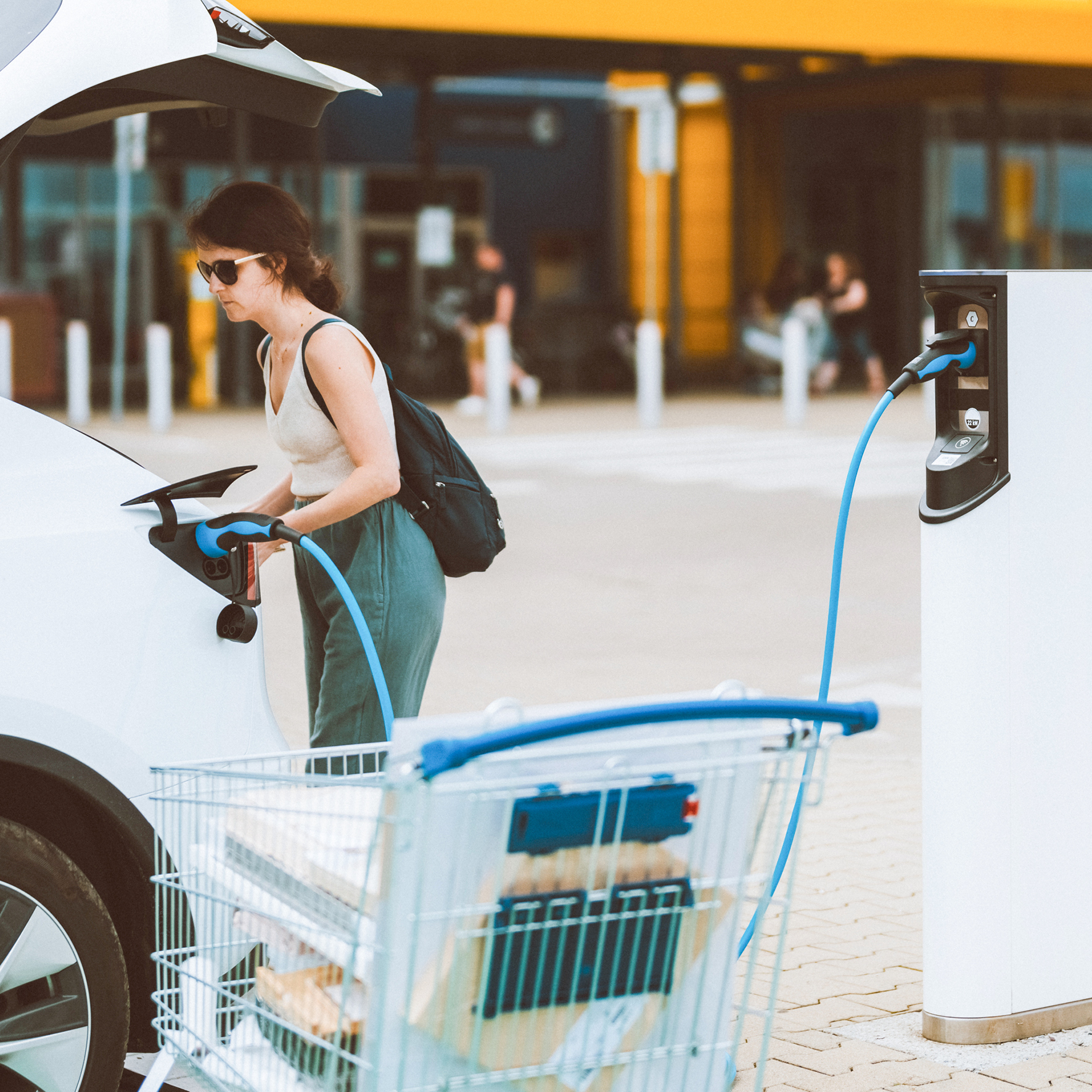Consider this: There are about to be 1.3 million opportunities that have never existed before for retailers, restaurants, and service providers. Those that jump on it first will reap the benefits.
All you have to do is plug in.
The transition of the American vehicle market from internal combustion engine (ICE) power to electric (EV) is happening faster, more furiously and at more price levels than anyone could have forecasted, even as recently as a year or two ago. In 2020, EVs represented barely two percent of the American market. They finished up 2022 with a six percent market share and worldwide, EVs are now 10 percent of the global market. And those numbers continue to grow as auto maker after auto maker promises to convert mostly – or in some cases entirely — to electric-powered vehicles within a decade.
Charge It
But here’s the problem…as well as the amazing opportunity for smart retailers. As quickly as American motorists are going electric, the infrastructure in place to charge all those vehicles is moving along at barely a snail’s pace. Right now, there are 145,000 fueling stations (with about 1.3 million pumps) in the U.S., and according to the Energy Department’s Alternative Fuels Data Center, there are about 56,000 public charging stations in the country. The number of actual charging devices is somewhat higher for customers charging from home. But S&P Global Mobility estimates the country will need about 1.3 million charging stations by the end of the decade. That’s just seven years away if your math skills are a little rusty.
A million charging stations are coming online within the next decade, and they bring with them a consumer who will have some time to kill – or make their charging needs into destinations. For retailers, it’s the next big opportunity to make some additional revenue and – OK, we had to say it – recharge their business models.
This is not just some idle projection. As part of the Biden administration’s package of spending that was approved and put into law last year the federal government has pledged to fund up to 500,000 charging stations by the year 2030. These stations are coming…the big questions remain where will they be and who will operate them?
As uncertain as those answers are, they do not have to be limited to existing gas stations.
Unlike the five or so minutes it takes to fuel up a vehicle with gas, charging electric vehicles on faster commercial-grade (as opposed to home) chargers can take anywhere from 15 minutes up to an hour to get from 20 percent to an 80 percent charge. Consumers are not going to stand by these electric “pumps” checking their emails and watching the world go by for all that time. They are going to want to do something else in the meantime.
Station to Station
Axios recently wrote about a trip one of its staffers took from Detroit to Florida and while they successfully navigated the less-than-satisfactory number of charging stations they used – 12 in all – their concerns were legitimate about the next stop. “We were constantly thinking about where to charge next. It occupied our minds more than where to eat or spend the night.”
That’s why the opportunity for both existing and new retailers, as well as restaurants and service providers, to become charging hubs is enormous. Imagine having a captive consumer who will spend the next 20-60 minutes at your business while their vehicle is charging. Imagine what they could buy, eat, and use while they are waiting. And this opportunity ranges from local residents making EV charging a destination to road warriors redefining a pit stop. The idea is to do two things at the same time. Retailers can make the charging experience into a destination that provides a service and a new revenue stream.
Six Easy Pieces
- Restaurants. Fast food and sit-down restaurants represent an easy entry point. They are certainly the most obvious business case for travelers (and locals) needing to recharge. They are already located along interstate highways and other travel corridors, and they almost always have parking lots that could accommodate charging terminals. In fact, many already have such stations now but usually on a limited basis. One early adapter is Subway which is testing a program of “Subway Oasis” charging parks at select locations along with a third party, Gen Z EV Solutions, which is providing the actual electric components. Setting aside an entire portion of their parking areas for charging structures would require fewer capital expenditures for restaurants than others looking to move into this business. The downside is what if the driver in question isn’t hungry, then what? Travelers’ meal planning becomes based on charging schedules.
- Convenience Stores. Today 127,000 of the 145,000 fueling stations are connected to convenience stores. This could be the way existing large gas stations, like those from chains such as Quik Trip and Speedway, take advantage of the charging surge. Again, some already have chargers, but the flaw here is that with many charging operations taking upwards of an hour that’s a long time to ask a driver to wander around the shelves of chips, oversized, overcaffeinated beverages and sugary treats. They will want something more, which might require these chains to expand into sit down dining areas. A pepperoni pizza and extra-large Diet Dr. Pepper might time out nicely for a full charge.
- Video & Gaming Arcades. We’re not talking about a couple of pinball machines and air hockey. Many malls are opening full-on gaming emporiums, ranging from aisles of machines to indoor miniature golf to escape rooms. The American Dream mall in New Jersey, which has made entertainment a cornerstone of its store mix, has several such places, all offering interactive gaming experiences. Mixed with snacks, it’s a good time killer. The downside: this appeals to a specific demographic and older drivers will no doubt fail to see the appeal of an hour’s worth of Grand Theft Auto.
- Gambling Casinos. What those older travelers might be more open to is an actual casino where the games are video poker and slot machines rather than Fortnite and Minecraft. In sanctioned locations, casino labor costs are limited, and you don’t need to be Steve Wynn to know these electronic gambling games can make a lot of money. The danger would be in drivers having enough money left to pay for their vehicle charging after spending an hour at the slots. Payment in advance would be a must.
- Beauty & Massage Services. This is not just about full color and highlights — but what about blow-outs, mani-pedis and spa services like massages? These kinds of service-oriented retailers are rapidly expanding and can’t be replicated online. This charging-with-wellbeing service can work for distance travelers along with neighborhood day spas (with parking lots). With the explosion of interest in pampering and self-improvement, this model is no longer exclusively limited to a traditionally female customer.
- You were waiting for this, weren’t you? All the other options have caveats but the fact of the matter is that 30 to 40 minutes of shopping appeals to just about everybody…everywhere…every time. These can be stores selling groceries, clothing, jewelry, fashion accessories, home and housewares, toys, shoes, sporting goods and just about anything you could buy at your local neighborhood Dick’s, Macy’s, Walmart, Kroger or even Neiman’s. In fact, there’s no reason to believe that as those chains look for new formats and enhancing their customer services, they couldn’t get in on this. More likely the opportunity is for the 34,000 dollar stores which know how to set up quickly and stock a store for maximum impulse sales. Let’s face it, charging stations have dollar signs written all over them.
To Infinity and Beyond
We bet if you gave it a little more thought you could come up with another list of retail businesses that could get into the charging game. And here’s the thing: if they don’t do it, somebody else will. A million charging stations are coming on line within the next decade, and they bring with them a consumer who will have some time to kill – or make their charging needs into destinations. For retailers, it’s the next big opportunity to make some additional revenue and – OK, we had to say it – recharge their business models.




